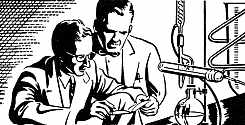|
They asked their chemical consultant, Dr. Robert Woodward, to help tackle first the job of producing the substitute optical material, and after months of work they solved the problem. Quinine was no longer necessary so there was really no need of trying to do the alternate job. But Woodward had often dreamed of synthesizing quinine and one day when the president of the company asked him if he thought there was any chance of doing it, Woodward immediately replied, "I believe it can be done!" So they tackled this very difficult job with its background of nearly a hundred years of failures - not to make a substitute for quinine but to reproduce the exact molecule.  On February 1, 1943, Woodward and his co-worker Bill Doering set out on their journey. They first built a wooden model of the quinine molecule consisting of 52 balls colored to represent the atoms of carbon, hydrogen, nitrogen and oxygen which make up the molecule. For months they labored only to discover that they were not hooking the atoms together in the right way. As Doering said, "We were ready to pack up and go home!" This happens at some time in nearly every research project. But after careful, investigation, they found a mistake had been made in the testing method. Then began the final spurt, and on April 10, 1944 - fourteen months after they started, they synthesized Pasteur's quinotoxine. Then by reversing Pasteur's process, the road was opened to the actual production of quinine itself. |








